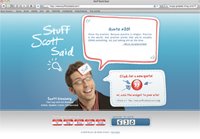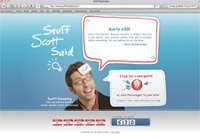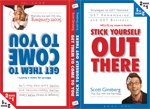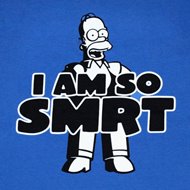 This is all Google’s fault.
This is all Google’s fault.
Think about it:
We have unlimited shelf space on which to share our ideas.
We have ubiquitous and instantaneous access to infinite knowledge.
We have completely democratized information, entertainment and media.
We have shattered the barriers to entry for previously impossible endeavors.
And we have allowed choice saturation to flatten the playing field, thus making thousands of niches as economically attractive as the mainstream.
THE RESULT: Everyone’s an expert.
Literally. I don’t mean that in the cliché sort of way.
WHAT I’M SAYING IS: With the right tools, the right resources and the right strategy, pretty much anyone in the world could position herself an expert (on anything!) in about a month.
Which brings me to my thesis:Experts are morons.
Just think about the last time you watched the news.
For seven minutes, you were subjected to the verbal diarrhea of some “expert” who invited himself onto the show to shamelessly promote his mediocre book written on the latest “hot issue” that he did a bunch of amateur “research” on but never actually experienced himself.
That’s an expert.
Anyone can be one.
And it’s no longer going to cut it in the marketplace.
HERE’S THE REALITY: If you want to reach the people who matter, if you want to deploy your message into to the marketplace, and if you want to create some serious change that moves the needle of the world, being an expert is not the answer.
Instead, I challenge you to be a thought leader.
What’s the difference between the two?
I’m glad you asked.
1. Definition. An expert is a person who has special skill or knowledge in some particular field. For her, it’s all about the person, her brain and the wisdom that comes from it. A thought leader is a trusted source that moves people with innovative ideas. For her it’s all about the message, its cause and the tribe that sustains it.
2. Nomination. Experts are experts because they say they are. It’s all about marketshare. And all you have to do is go to their website to see how much of an expert they claim to be. Thought leaders are thought leaders because the world says they are. It’s more about mindshare. And all you have to do is go to Google to see how much of an expert the marketplace claims them are.
3. Disposition Experts are smart, creative people who have lots of ideas. And they accumulate knowledge from other people’s resources for the purposes of memorization and monetization. Thought leaders are intellectual, innovative people who actually execute ideas. And they extract universal truths from their own experience for the purpose democratization and exploration.
4. Content. Experts memorize facts and technical knowledge. They lick the seal and tell you what to think about the envelope. Thought leaders notice connections and patterns. They push the envelope by ripping it open and challenge you to rethink your illusions about what’s inside of it.
5. Surroundings. An expert is an island. He puts himself up on a pedestal above the audience. And he capitalizes on the power of his brain to put a stake in the ground. A thought leader is building a following. He builds a platform to cement an ongoing relationship with his audience. And capitalizes on the power of his community to push the ideas forward.
6. Structure. Experts assign formulas. Their material is non-updatable, unshakable and inelastic. Their attitude is inflexible, choreographed, canned, insincere, inauthentic and preplanned. They’re often resisted, debated and create defensiveness. And their rigid, rote learning limits people’s possibilities and stifles their creativity. Thought leaders suggest practices. Their material comes in the form of simple, doable and human actions. Their actions insinuate instead of impose. They’re adaptable and applicable to various situations and individuals. And their work is easily digested, self-evident, non-threatening and encourage people’s creativity.
7. Derivation. Experts are answer-driven. They’re finished learning the material. And they puke regurgitated wisdom, give excellent book reports and peddle plagiarized insight. This helps them make money. Thought leaders are question-driven. They lead the dialogue on the evolution of the material. And they deliver actionable lessons that passed through the test of their personal experience. This helps them make history.
8. Publishing. Experts have written. They published their knowledge – at some point in the past – because was good for their career, attracted some attention and left a trail of digital breadcrumbs back to their website so people could hire them for high-end consulting jobs. Thought leaders are always writing. And they continue to syndicate their wisdom – every single day – because it contributes to their ongoing body of work, validates their existence and leaves a literary footprint to inspire future generations to execute what matters.
9. Delivery. Experts prove themselves; thought leaders express themselves. Experts strive for approval; thought leaders allow for refusal. Experts proclaim their superiority; thought leaders embody their fabulousness. Experts demand their rights, thought leaders deploy their gifts. Experts talk smack; though leaders do acts. Experts play to the crowd; thought leaders play for the sake of playing. Experts win with lip service through swell argument; thought leaders win with foot service through swift action. And experts advise people from the outside; while thought leaders inspire people from the inside.
10. Modality. The final differentiator between an expert and a though leader is the overall approach they take to life and work. First, experts believe things. And talk about things. And sometimes even do things. And they survive on a steady diet of orthodoxy, or, the right thoughts. They practice what they preach, but the message they preach isn’t necessarily the dominant truth of their life. Thought leaders, on the other hand, simply are. It’s less about believing and talking and doing and more about just being. They survive on a steady diet of orthopraxy, or, the right actions. They preach what they practice, and the gap between their onstage performance and backstage reality is non-existent.
That’s why I challenged you to stop acting like an expert and start being a thought leader.
Because that’s what it really comes down to:
Experts persuade, pontificate and profit through doing. Because they’re full of themselves.
Thought leaders inspire, infect and influence through being. Because they’re sharing themselves.
Take your pick.
P.S. Special thanks to all the thought leaders on my Facebook page whose ideas helped inspire this post!
LET ME ASK YA THIS…
Which one are you?
LET ME SUGGEST THIS…
For the list called, “23 Ways to Turn Thoughts into Messages,” send an email to me, and you win the list for free!
* * * *
Scott Ginsberg
That Guy with the Nametag
Author, Speaker, Entrepreneur, Mentor
[email protected]
 Who’s quoting YOU?
Who’s quoting YOU?
Check out Scott’s Online Quotation Database for a bite-sized education on branding success!

 If you want the marketplace to recognize you as a Smokin’ Hot Piece of Brain Candy, “thinking” is not your main responsibility.
If you want the marketplace to recognize you as a Smokin’ Hot Piece of Brain Candy, “thinking” is not your main responsibility. Who’s quoting YOU?
Who’s quoting YOU? According to the U.S. National Weather Service, the odds of being struck by lightning in your lifetime are 1 in 6,250.
According to the U.S. National Weather Service, the odds of being struck by lightning in your lifetime are 1 in 6,250.
 “I invoke your name a lot.”
“I invoke your name a lot.” The world’s FIRST two-in-one, flip-flop book!
The world’s FIRST two-in-one, flip-flop book! As a Thought Leader, you need to be a master of your subject.
As a Thought Leader, you need to be a master of your subject. The world’s FIRST two-in-one, flip-flop book!
The world’s FIRST two-in-one, flip-flop book! Fantastic! You’ve just learned something new.
Fantastic! You’ve just learned something new. Still haven’t written your book yet?
Still haven’t written your book yet? “Why are they talking to THAT idiot?!” you scream at the TV.
“Why are they talking to THAT idiot?!” you scream at the TV. Enjoy this post?
Enjoy this post?